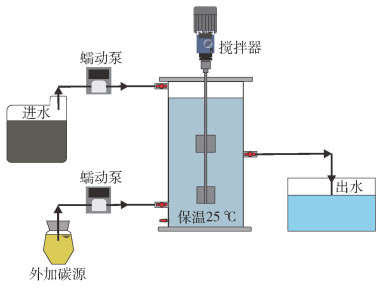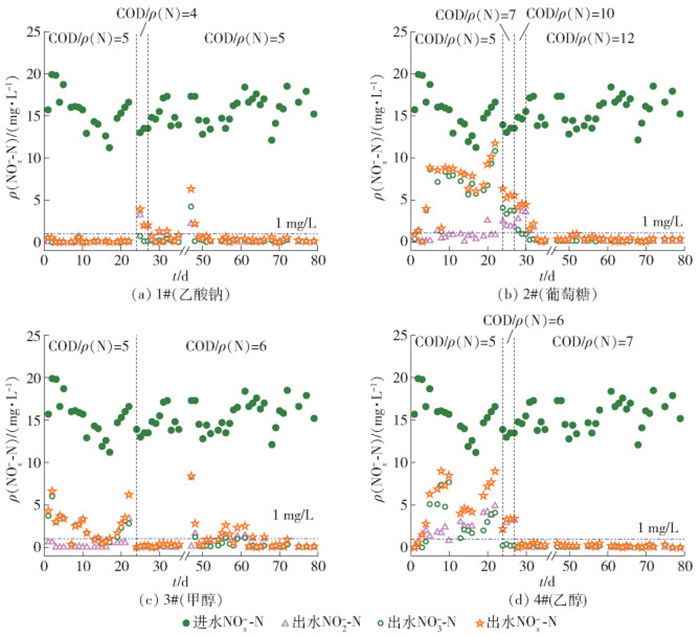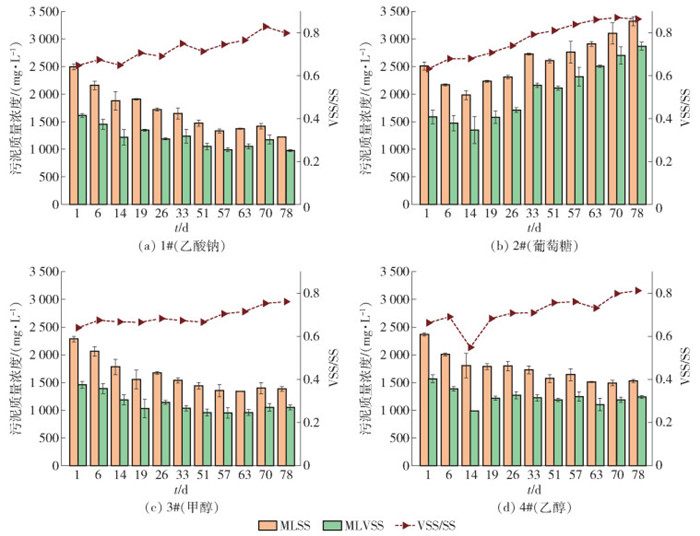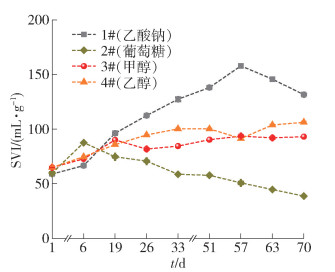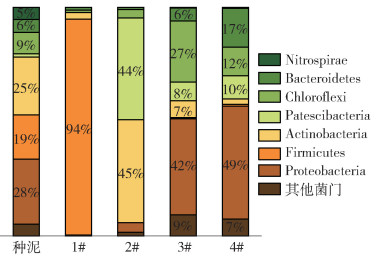Effect of Four Different Types of Carbon Sources on Advanced Nitrogen Removal of Secondary Effluent: System Performance and Microbial Communities
-
摘要:
城市污水处理厂出水符合一级A排放标准,其中含有的硝酸盐氮仍可能引起敏感水域水质恶化,故仍需进一步开发尾水深度脱氮技术.研究采用乙酸钠、葡萄糖、甲醇、乙醇4种碳源作为外加碳源,探究序批式反应器(sequencing batch reactor,SBR)悬浮污泥系统进行城市污水厂尾水深度脱氮的可行性.试验结果表明:在进水硝酸盐质量浓度约为15 mg/L、硝酸盐氮容积负荷率为0.03 kg/(m3·d)的条件下,分别投加4种不同的碳源,SBR均能达到97.80%以上的NOx--N去除率,出水ρ(NOx--N) < 1 mg/L.4个系统实现稳定深度脱氮所需的COD/ρ(N)分别为5、12、6和7,对应去除1 g NOx--N的碳源量分别为7.35、12.00、4.00和3.37 g,其中乙醇为碳源时投加量最低而葡萄糖为碳源时最高.使用原位全周期方法测得的4个系统平均氮去除速率分别为0.72、0.19、0.32和0.73 kg/(m3·d),其中乙醇和乙酸钠为碳源时反应速率最高而葡萄糖为碳源时最低.碳源种类对微生物种群组成具有显著影响.经过78 d的培养之后,乙酸钠和葡萄糖系统污泥与接种污泥相比种群结构简单,乙酸钠为碳源时微生物以Firmicutes门为主(94%),葡萄糖为碳源时微生物以Actinobacteria门(45%)和Patescibacteria门(44%)为主.与之相反,甲醇、乙醇系统中微生物种群的多样性比起种泥有所上升.
Abstract:Even discharge standard grade A is achieved in wastewater treatment plants (WWTPs), the effluent still contains abundant nitrogen pollution, which can cause deterioration of quality of sensitive receiving waters. Thus, development of tertiary denitrification technique to advanced nitrogen removal is required. In this study, four liquid carbon sources, including sodium acetate, glucose, methanol and ethanol were used as external carbon sources to explore the feasibility of using the sequencing batch reactor (SBR) suspended sludge system to further remove low-level nitrogen from secondary effluent. The experimental results show that when the nitrogen volume loading rate was 0.03 kg/(m3·d), all of four denitrifying-sequencing batch reactor (DN-SBR) systems can reach a NOx--N removal efficiency of more than 97.80% with effluent NOx--N less than 1 mg/L. The COD/ρ(N) required for the four systems were 5, 12, 6, and 7, corresponding to a carbon source required of 7.35, 12.00, 4.00, and 3.37 g/g NOx--N, respectively. The required dose of ethanol was the lowest and the glucose was the highest for complete denitrification. Determined by in-situ measurement method, the average nitrogen removal rates of the four systems were 0.72, 0.19, 0.32 and 0.73 kg/(m3·d), respectively. The ethanol and acetate system presented higher reaction rate and the glucose system was the lowest. There were great differences between the compositions of microbial community in these reactors added with different carbon sources. After an operational period of 78 d, the diversity of microbial communities in acetate- and glucose systems decreased. Firmicutes phylum microorganisms dominated in the reactor with acetate, accounting for 94% of the total microorganisms. The dominated phylums in the glucose-reactor were Actinobacteria (45%) and Patescibacteria (44%). In contrast, the diversity of microbial communities in the methanol and ethanol systems increased compared to that of seed sludge.
-
我国一些超敏感水域如太湖、巢湖的富营养化程度严重,氮元素严重超标[1]. 水体氮元素含量过高是造成富营养化的重要原因[2-3],因此严格控制超敏感水体氮素的输入对生态环境修复至关重要. 城市污水是天然水体重要的污染源,在排放到受纳水体前需要进行严格的处理. 虽然国家针对污水处理厂的出水制定了严格的排放标准,但是对于超敏感水域,即使城市污水处理厂的出水满足一级A排放标准(GB18918—2002),尾水中的氮元素仍足以引起这些水域富营养化现象的恶化[4]. 为实现敏感水域的水环境质量提升,一些地区针对城市污水处理提出了更为严苛的总氮排放标准. 对于特定条件下的污水处理厂出水,要求达到我国《地表水环境质量标准》(GB3838—2002)中Ⅲ类水标准,即出水ρ(TN) < 1mg/L. 然而,现有污水处理厂生化处理工艺出水稳定达到一级A排放标准已有较大困难,为使污水处理厂最终排水满足ρ(TN) < 1mg/L,仍需进一步优化工艺流程以削减出水中的氮元素.
城市污水处理厂尾水中总氮削减的重点和难点是硝态氮(NO3--N)的去除. 硝态氮化学性质稳定,使用化学法和物理法脱除成本高昂. 而生物法去除硝酸盐的成本相对较低,是目前应用较为广泛的尾水深度脱氮工艺. 目前对生物法尾水脱氮的工艺形式包括生物滤池[5-9]和人工湿地[10-11]. 然而生物滤池工艺运行灵活性不够,且容易受到传质限制,出水难以稳定小于1mg/L. 而人工湿地工艺占地面积较大,且处理效果受季节影响显著,不适宜在水量较大的城市污水处理中使用. 序批式反应器(sequencing batch reactor,SBR)悬浮培养系统运行方式灵活[12],占地面积小,具有理想的推流过程. 此外,活性污泥系统的出水总氮理论上能够稳定低于1mg/L. 因此SBR可用于城市污水处理厂尾水深度脱氮.
目前利用SBR进行反硝化的长期[13]及短期[14]试验已有很多,但基于城市污水处理厂尾水水质的研究仍较为缺乏. 城市生活污水厂尾水的低基质条件可能对微生物生长产生不利影响,导致脱氮系统不稳定. 因此该系统处理实际城市尾水的可行性仍有待进一步研究. 此外,城市尾水中生物可利用有机物含量低,通常需要外加电子供体来实现深度脱氮. 电子供体的种类对反硝化速率和效率具有重要影响. 近年来关于反硝化外加电子供体有许多新进展,包括新型的电子供体,如气态电子供体(CH4、H2S)[13]、固态碳源[14]和无机电子供体(氢、硫等)[15-16]. 但目前气态碳源反应装置构造复杂昂贵,且脱氮效果不理想;固态碳源造价普遍昂贵,而其中价格低廉的植物源材料具有碳超标问题;无机电子供体普遍具有反应速率低或操作复杂的问题. 以上碳源目前尚难以直接应用到城市尾水处理中. 考虑到城市尾水脱氮对反硝化速率和效率的要求,投加液态碳源如甲醇[17]、乙醇、葡萄糖和乙酸钠等仍是适宜选择. 但是不同外碳源对系统的反硝化过程影响不同[18],故需研究不同碳源对系统脱氮性能的影响. 除此之外,微生物种群结构可反映碳源对系统影响的潜在机制. 针对微生物种群结构的研究有助于理解不同碳源对脱氮的影响机制并促进工艺优化.
综上,本试验采用乙酸钠、葡萄糖、甲醇、乙醇4种常用液体碳源,在城市尾水条件下构建反硝化SBR悬浮培养系统(DN-SBR),验证在DN-SBR系统中稳定实现NOx--N(硝态氮与亚硝态氮)质量浓度之和小于1mg/L的可行性,并结合高通量测序技术对4个系统内的微生物种群结构进行分析,以期为城市尾水深度脱氮问题提供参考与借鉴.
1. 材料与方法
1.1 试验水质
试验用水分为进水和外碳源. 进水以实验室规模生化反应器出水为基础,添加适量30g/L NaNO3溶液配制成模拟水厂尾水,每日配制1次,试验期间反应器平均进水水质如表 1所示.
表 1 试验进水水质Table 1. Characteristics of wastewater参数 ρ(NO2--N)/(mg·L-1) ρ(NO3--N)/(mg·L-1) COD/(mg·L-1) 温度/℃ pH 均值 0.34 15.40 27.23 25 8.29 范围 0~1.87 10.81~19.94 13.19~46.02 24.50~25.50 7.79~8.51 根据所需碳氮比,将碳源溶解于去离子水中配制成溶液并置于1L玻璃瓶中,每周期使用蠕动泵加入60mL,通过调节外碳源溶液的质量浓度来形成不同的进水COD/ρ(N). 所使用的碳氮比以COD/ρ(N)计,按照NO3--N质量浓度为15mg/L来设计外投碳源所用的COD/ρ(N),并在实际测定后,以1g无水乙酸钠对应0.68g COD、1g一水合葡萄糖对应1.00g COD、1g甲醇对应1.50g COD、1g乙醇对应2.08g COD来计算对应碳源溶液的质量浓度. 乙酸钠、葡萄糖分别采用固态分析纯无水乙酸钠和固态分析纯一水合葡萄糖进行配制,甲醇、乙醇溶液碳源使用分析纯液态甲醇和分析纯液态乙醇通过去离子水稀释而成.
试验所用的接种污泥来自北京高碑店污水处理厂AAO工艺的回流污泥,该工艺主要处理城市生活污水. 接种后污泥质量浓度MLSS为(2412±107)mg/L,MLVSS为(1557±67)mg/L.
1.2 试验装置及运行阶段
试验采用4个SBR进行(见图 1). 反应器材质为有机玻璃,高48.00cm,内径17.50cm,有效容积10L. 使用精度为0.50℃的温控探头和自带温控的加热棒共同控制系统温度为25℃左右. 原水和外加碳源分别使用2个蠕动泵由原水箱加入. 4个反应器分别投加乙酸钠、葡萄糖、甲醇、乙醇作为外加碳源并分别编号为1#、2#、3#、4#. 4个反应器运行周期相同且在整个试验过程中保持不变. 每周期4h,包含14min进水、2h搅拌、30min排水和76min闲置,排水比50%. 根据不同的COD/ρ(N)分为4个运行阶段. 反应各阶段所用COD/ρ(N)见表 2.
表 2 试验运行阶段Table 2. Operating phase of the experiment阶段 反应器所采用CODCr/ρ(N) 1#
乙酸钠2#
葡萄糖3#
甲醇4#
乙醇Ⅰ(第0—24天) 5 5 5 5 Ⅱ(第25—27天) 4 7 6 6 Ⅲ(第28—30天) 5 10 6 7 Ⅳ(第31—80天)① 5 12 6 7 ①其中第36—46天由于春节停止运行11d. 1.3 分析项目与方法
试验期间每天对进出水中NO2--N、NO3--N、CODCr的质量浓度进行测定. NO2--N和NO3--N采用Metrohm Compact IC-861离子色谱仪进行测定,色谱柱型号为ASUPP5_150,测定前使用0.22μm孔径滤膜进行过滤;CODCr采用兰州连华5B-1型COD快速测定仪测定;pH、DO、温度采用德国WTW便携式检测仪(Multi340i)检测;混合液悬浮固体浓度(MLSS)和挥发性悬浮固定浓度(MLVSS)采用标准重量法(100mL)测定;污泥体积系数(SVI30)采用国标法,但以100mL玻璃量筒取代1L量筒测定.
在培养第77天的稳定状态下采用原位全周期法测定系统的平均氮去除速率. 在第77天时对反应器NOx--N的周期变化进行测定,1#、2#、3#、4#反应器中所使用COD/ρ(N)分别为5、12、6、7,数据显示,在从起始值反应至ρ(NOx--N) < 1mg/L的过程中,去除量与时间成良好线性关系(R2>0.80). 故将搅拌开启第5秒(0.08min)时系统的NOx--N质量浓度计为起始质量浓度S0,将系统该周期首次ρ(NOx--N) < 1mg/L时的时间计为t1,此时NOx--N质量浓度计为S1,用
$$ 平均氮去除速率 = \frac{{{S_0} - {S_1}}}{{({t_1} - 0.08)}} \times 1.44 $$ 计算系统平均氮去除速率. 单位:kg/(m3·d).
1.4 高通量测序及分析方法
在运行第78天时,分别取4个反应器搅拌均匀的状态下的污泥样品100mL,离心3min,使用冻干机在-50℃下进行真空冻干(LABCONCO Co.,Free Zone,USA),随后将4个污泥样品和接种污泥的样品送至上海美吉生物医药科技有限公司进行高通量测序分析,样品16SrRNA中的V3-V4区被扩增,所用引物为338F (5′-ACTCCTACGGGAGGCAGCAG-3′)与806R (5′-GGACTACHVGGGTWTCTAAT-3′). 高通量原始序列已上传至NCBI数据库,项目编号为PRJNA597417. 对获得的5个样品的高通量数据进行处理,以3%的差异阈值将其分类为序列聚类操作分类单元(operational taxonomic units, OTUs),共获得3980个OTUs,随后使用平台对所获结果进行分析.
2. 结果与讨论
2.1 反硝化系统的启动及去除效果的达成
4个系统启动期间的长期运行数据如图 2所示,可见随着COD/ρ(N)的调整,投加足量的碳源,4个反应器的出水NOx--N均稳定小于1mg/L,符合地表Ⅲ类水的总氮标准. 出水总氮在40d的运行时间内始终低于1mg/L,系统脱氮效果稳定.
投加不同碳源,系统的启动过程有所不同. 乙酸钠系统在起始COD/ρ(N)=5状态下几乎无须适应过程,在第1天便达到了ρ(NOx--N) < 1mg/L的去除目标并维持稳定的去除效果. 在第24天降低COD/ρ(N)至4,反应器在调整当天出水NOx--N迅速达到3.90mg/L,并在接下来的2d中稳定保持在2.00mg/L. 在第27天时将进水COD/ρ(N)调回至5,系统出水效果有所恢复,但有较大波动. 春节期间停止运行11d并在4℃下保存污泥,随后重新以进水COD/ρ(N)=5启动反应器,3d后系统重新恢复稳定状态,出水硝酸盐低于1mg/L并维持了40d以上.
葡萄糖系统在起始COD/ρ(N)=5条件下,虽然在第1天和第3天出水达到ρ(NOx--N) < 1mg/L的要求,但随后的19d里出水均值高达6.80mg/L且在系统中出现了氮素的累积,其中,由于之前运行周期中氮素去除不完全,第22天出水ρ(NOx--N)高达11.7mg/L,但COD有明显下降. 随后将进水COD/ρ(N)提升到7并进一步提高到10. 系统脱氮效果每次处理都会有所上升并在3d内处理效果稳定无继续提高,其中出水ρ(NOx--N)在COD/ρ(N)=7时稳定在5.5mg/L而COD/ρ(N)=10时稳定在4.4mg/L,第27天时提高COD/ρ(N)至12,出水在2d内达到ρ(NOx--N) < 1mg/L并维持稳定.
甲醇系统在进水COD/ρ(N)=5时,出水ρ(NOx--N)在0.33~6.24mg/L波动,出水ρ(NOx--N)偶尔能小于1mg/L. 当碳源投加量增加,进水COD/ρ(N)为6时,出水ρ(NO-x-N)低于1mg/L并保持稳定. 反应器停止运行后重新启动,进水COD/ρ(N)=6,系统第3天恢复到原有水平,出水ρ(NOx--N) < 1mg/L. 但系统的反硝化性能不稳定,可能是冷藏所致. 第64、65天增加碳源的投加量使进水COD/ρ(N)=7,系统脱氮性能恢复到原有水平,并在进水COD/ρ(N)恢复至6时保持稳定.
乙醇系统在进水COD/ρ(N)=5条件下运行,与葡萄糖系统类似,系统出水NOx--N仅在第1天和第2天小于1mg/L,随后在1.5~9.0mg/L之间波动. 增加碳源投加量至进水COD/ρ(N)=6,2d后系统出水NOx--N稳定在3.30mg/L左右. 碳源投加量进一步增加,进水COD/ρ(N)=7,出水NOx--N低于1mg/L并保持稳定. 反应器停止运行后重新启动,进水COD/ρ(N)=7,系统出水在第1天便恢复到原有水平,出水硝酸盐低于1mg/L并较为稳定.
表 3展示了反应器稳定阶段(第50—79天)的脱氮性能. 4个反应器的NOx--N去除率均达到97.80%以上,出水平均NOx--N质量浓度低于1mg/L. 其中乙醇为外加碳源时,系统的NOx--N去除率和去除速率最高,且去除每克硝酸盐所需要的碳源投加量最低. 而葡萄糖为外加碳源时,反应速率最慢且去除每克硝酸盐所需的碳源投加量最高.
表 3 稳定阶段DN-SBR脱氮性能Table 3. Steady state performance of DN-SBR反应器
编号1g硝酸盐所需投加碳源量/g
(还原1g硝酸盐所消耗碳源量/g)进水ρ(NOx--N))/
(mg·L-1)①出水ρ(NOx--N)/
(mg·L-1)平均NOx--N
去除率②/%平均氮去除速率/
(kg·m-3·d-1)1# 7.35(6.71±0.63) 16.5±1.7 0.26±0.19 98.4 0.72 2# 12.00(11.28±1.48) 16.4±1.8 0.31±0.23 98.1 0.19 3# 4.00(3.78±0.60) 16.4±1.7 0.35±0.35 97.8 0.32 4# 3.37(3.17±0.85) 16.5±1.7 0.17±0.12 98.9 0.73 ①进水中,NO3--N占据进水NOx--N中的97.7%~98.1%.
② $ {\rm{平均NO}}_x^ - {\rm{ - N去除率}} = \frac{{平均进水\rho ({\rm{NO}}_x^ - - {\rm{N}}) - 平均出水\rho ({\rm{NO}}_x^ - - {\rm{N}})}}{{平均进水({\rm{NO}}_x^ - {\rm{ - N}})}} \times 100\% $2.2 反应器污泥质量浓度及沉降性
4个系统的污泥质量浓度变化如图 3所示. 初始阶段4个系统污泥质量浓度均有所下降并最终稳定,而葡萄糖作为外加碳源时系统的污泥质量浓度还有所上升. 污泥质量浓度的下降可能是由于不适宜反硝化条件的菌群被逐渐淘洗,但同时观察到4个系统中VSS/SS指数均逐渐增大且污泥质量浓度最终趋于稳定,这表明菌群由原始混合菌群向适宜反硝化的菌群的逐渐演变和最终稳定.
此外,图 4展示了4个系统污泥沉降性能的变化情况. 在初始运行阶段,4个系统的SVI均有一定上升,系统污泥沉降性能的下降可能与较低的基质浓度有关. 随着反应的进行,各个反应器的污泥沉降性能均在最后2周进入不断好转或较为稳定的状态.污泥沉降性能发生好转,出水悬浮物质量浓度降低,为系统污泥质量浓度的稳定提供了有利条件,并进一步说明系统达到相对稳定的状态. 乙酸钠作为外加碳源时,系统的污泥沉降性能变化情况最为明显,最高值达到157.90mL/g,已发生轻微的污泥膨胀. 这可能是由于该体系较低的有机负荷引起了丝状菌膨胀. 张立卿等[19]的研究报道了在低有机负荷下投加乙酸钠的反硝化除磷体系出现的丝状菌膨胀现象. 而杨雄等[20]的研究进一步显示,在较低的有机负荷下,随体系反应时间的延长,投加乙酸钠的体系比投加葡萄糖的体系更早发生污泥膨胀.
2.3 不同碳源反硝化系统的高通量测序分析
表 4展示了种泥及使用不同碳源培养78d后的4个反硝化系统污泥样本在OTUs水平上的Chao1、Shannon、Simpson、Sobs、Ace指数. 数据显示,与种泥相比,当乙酸钠和葡萄糖为外加碳源时,系统的微生物多样性大幅下降,其中以乙酸钠系统最为明显. 这可能说明在乙酸钠系统中存在竞争力极强的优势菌种,导致其他微生物种群被逐渐淘洗;而以醇类(甲醇、乙醇)为外加碳源培养的样品中微生物多样性反而有一定上升,且乙醇系统微生物多样性上升更多.
表 4 样品物种多样性指数Table 4. Diversity statics for samples样品 OTUs Chao1
指数Shannon
指数Simpson
指数Sobs
指数Ace
指数种泥 823 918 4.53 0.04 823 918 1# 360 488 2.56 0.15 360 488 2# 659 899 2.71 0.17 659 899 3# 1052 1224 4.72 0.04 1052 1224 4# 1063 1192 4.97 0.02 1063 1192 注:OTUs、Chao1指数、Shannon指数、Sobs指数、Ace指数越大,Simpson指数越小,说明种群物种多样性越高. 图 5展示了接种污泥和4个SBR系统中微生物门水平上的组成. 与种泥相比,4种碳源培养下的反硝化污泥的物种组成发生显著变化. Nitrospirae门生物通常在硝化过程中起到重要作用,而由于培养环境缺乏氧气和氨氮,4种污泥中的Nitrospirae门生物几乎被淘洗完全. 综合看4种污泥中的物种变化,发现在乙酸钠、甲醇、乙醇系统中,Actinobacteria门生物占比均明显下降,而在葡萄糖系统中,该门生物占比由种泥中的25%提升至45%,这可能说明Actinobacteria门生物在葡萄糖代谢中具有重要作用. Ito等[21]采用MAR-FISH方法对厌氧消化污泥进行研究,结果显示所构建的克隆文库中有一半都是Actinobacteria门生物,故认为其为主要的葡萄糖降解生物. 同样地,Firmicutes门生物在葡萄糖、甲醇、乙醇系统中的相对丰度显著下降,而在乙酸钠系统中由种泥的19%提升至94%,具有绝对优势的占比说明Firmicutes门生物在乙酸钠为碳源的反硝化系统中可能具有强竞争优势,且应具有反硝化功能. Firmicutes门是厌氧环境下重要的反硝化菌[22-23]. Deng等[24]以乙酸钠为外加碳源,使用SBR悬浮培养系统进行反硝化反应,硝态氮去除率在高碳氮比条件下接近100%,而Firmicutes门生物占据优势地位. 以上结果和本研究共同说明了Firmicutes门生物在乙酸钠为碳源的反硝化系统中具有优势作用,可能与高进水碳氮比条件下形成的厌氧环境有关. 种泥中的结果也与以上现象一致,这2个菌门的生物在种泥中均占有较大比例,而种泥所处环境为生活污水,其中常含有较高含量糖类,该种泥原有工艺中也需投加乙酸钠作为补充碳源.
在反应初期,葡萄糖反应器中的硝态氮除了稀释作用外几乎没有下降,即反硝化几乎没有发生,但COD有明显消耗现象. 这可能是由于在培养初期,葡萄糖系统中能够利用或吸附葡萄糖的主要为无明显反硝化作用的微生物,当增大供给的碳源量至COD/ρ(N)=12时,反硝化微生物富集,硝态氮被高效去除. 污泥培养过程中微生物群落的变化情况与之一致. 种泥中Actinobacteria门已有25%相对丰度,培养78d后其相对丰度继续提高至45%,该类微生物可降解葡萄糖,但是不以硝态氮为电子受体;而起始时种泥中Patescibacteria门相对丰度非常低,对资源的竞争能力可能相对很弱,而培养78d后其相对丰度增长至44%,与Actinobacteria门几乎相当. Patescibacteria门是2018年来提议组建的超级类群,该门生物的专门研究目前还比较少,在本试验中可能起到反硝化作用. 但是目前尚未见到该类微生物具有直接与反硝化性能相关的报道[25]. 葡萄糖系统中该门生物在纲水平上主要为Saccharimonadia纲,据报道该纲生物可能与有机物代谢相关且易在高氮条件下聚集[26],结合该门生物在甲醇、乙醇系统中增加的现象,猜想该门生物可能具有利用有机物进行反硝化的作用.
相比于乙酸钠系统和葡萄糖系统,甲醇和乙醇系统在门水平上的种群分布具有较高的相似性. 2个系统中Proteobacteria门相对丰度均有显著提升且占据主导地位,而Proteobacteria门中包含常见的反硝化功能菌[27],可能与系统反硝化性能的提升密切相关. Chloroflexi和Patescibacteria门相对丰度也均有一定提升,这2个门的生物可能与醇的代谢相关,Chloroflexi门生物本身是重要的反硝化相关门类,其中的Anaerolineaceae科、Caldilineaceae科、JG30-KF-CM45目生物具有反硝化功能[26],而这些生物在2个系统的Chloroflexi门生物中占比较高,可能发挥一定反硝化作用,而考虑到Pastescibacteria门在葡萄糖系统中的表现,该门生物可能具有有机物利用和反硝化作用.
甲醇和乙醇系统的种群结构也存在一定差异. 甲醇系统中Chloroflexi门相对丰度明显高于乙醇系统,而Bacteroidetes门显著较低. 甲醇系统的环境可能利于Chloroflexi门生物的生长.
3. 结论
本研究对在4种碳源条件下,SBR城市尾水深度脱氮系统的性能和微生物种群结构进行了探究,主要结论如下.
1) 在氮容积负荷率为0.03kg/(m3·d)的情况下,4种外加碳源所构建的DN-SBR系统在无曝气条件下持续运行78d,污泥浓度和沉降性能均能逐渐稳定. 在稳定阶段,4个系统的NOx--N去除率均可达到97.8%以上,能够满足出水ρ(NOx--N) < 1mg/L的排放目标. 稳定的污泥性能和良好的脱氮性能说明该深度脱氮系统具有可行性.
2) 在本试验中,4个系统实现该去除效果所采取的COD/ρ(N)分别为:乙酸钠系统COD/ρ(N)=5,葡萄糖系统COD/ρ(N)=12,甲醇系统COD/ρ(N)=6,乙醇系统COD/ρ(N)=7,若根据前述比例换算为需采用的碳源量,则对应1g NOx--N投加的碳源量分别为7.35、12.00、4.00、3.37g. 4个系统的平均氮去除速率分别为0.72、0.19、0.32、0.73kg/(m3·d). 乙醇系统具有最高的平均氮去除效率和平均氮去除速率,且所需碳源量最低,表现为本系统最适合的碳源. 而葡萄糖系统需要消耗最多的碳源量且反应速率最慢.
3) 碳源种类对该系统微生物种群组成具有显著影响. 乙酸钠和葡萄糖为碳源的系统污种群结构单一,其中Firmicutes门微生物占据乙酸钠系统微生物总量的94%,Actinobacteria门和Patescibacteria门分别占据葡萄糖系统微生物总量的45%和44%;与之相反,甲醇、乙醇系统中微生物种群的多样性有所上升.
-
表 1 试验进水水质
Table 1 Characteristics of wastewater
参数 ρ(NO2--N)/(mg·L-1) ρ(NO3--N)/(mg·L-1) COD/(mg·L-1) 温度/℃ pH 均值 0.34 15.40 27.23 25 8.29 范围 0~1.87 10.81~19.94 13.19~46.02 24.50~25.50 7.79~8.51 表 2 试验运行阶段
Table 2 Operating phase of the experiment
阶段 反应器所采用CODCr/ρ(N) 1#
乙酸钠2#
葡萄糖3#
甲醇4#
乙醇Ⅰ(第0—24天) 5 5 5 5 Ⅱ(第25—27天) 4 7 6 6 Ⅲ(第28—30天) 5 10 6 7 Ⅳ(第31—80天)① 5 12 6 7 ①其中第36—46天由于春节停止运行11d. 表 3 稳定阶段DN-SBR脱氮性能
Table 3 Steady state performance of DN-SBR
反应器
编号1g硝酸盐所需投加碳源量/g
(还原1g硝酸盐所消耗碳源量/g)进水ρ(NOx--N))/
(mg·L-1)①出水ρ(NOx--N)/
(mg·L-1)平均NOx--N
去除率②/%平均氮去除速率/
(kg·m-3·d-1)1# 7.35(6.71±0.63) 16.5±1.7 0.26±0.19 98.4 0.72 2# 12.00(11.28±1.48) 16.4±1.8 0.31±0.23 98.1 0.19 3# 4.00(3.78±0.60) 16.4±1.7 0.35±0.35 97.8 0.32 4# 3.37(3.17±0.85) 16.5±1.7 0.17±0.12 98.9 0.73 ①进水中,NO3--N占据进水NOx--N中的97.7%~98.1%.
② $ {\rm{平均NO}}_x^ - {\rm{ - N去除率}} = \frac{{平均进水\rho ({\rm{NO}}_x^ - - {\rm{N}}) - 平均出水\rho ({\rm{NO}}_x^ - - {\rm{N}})}}{{平均进水({\rm{NO}}_x^ - {\rm{ - N}})}} \times 100\% $表 4 样品物种多样性指数
Table 4 Diversity statics for samples
样品 OTUs Chao1
指数Shannon
指数Simpson
指数Sobs
指数Ace
指数种泥 823 918 4.53 0.04 823 918 1# 360 488 2.56 0.15 360 488 2# 659 899 2.71 0.17 659 899 3# 1052 1224 4.72 0.04 1052 1224 4# 1063 1192 4.97 0.02 1063 1192 注:OTUs、Chao1指数、Shannon指数、Sobs指数、Ace指数越大,Simpson指数越小,说明种群物种多样性越高. -
[1] YU C, HUANG X, CHEN H, et al. Managing nitrogen to restore water quality in China[J]. Nature, 2019, 567(7749): 516-520. doi: 10.1038/s41586-019-1001-1
[2] CONLEY D J, PAERL H W, HOWARTH R W, et al. Ecology controlling eutrophication: nitrogen and phosphorus[J]. Science, 2009, 323(5917): 1014-1015. doi: 10.1126/science.1167755
[3] HOWARTH R W, MARINO R. Nitrogen as the limiting nutrient for eutrophication in coastal marine ecosystems: evolving views over three decades[J]. Limnology and Oceanography, 2006, 51(12): 364-376. http://www.onacademic.com/detail/journal_1000037418059910_8436.html
[4] WANG Y, LIN Z, WANG Y, et al. Sulfur and iron cycles promoted nitrogen and phosphorus removal in electrochemically assisted vertical flow constructed wetland treating wastewater treatment plant effluent with high S/N ratio[J]. Water Research, 2019, 151: 20-30. doi: 10.1016/j.watres.2018.12.005
[5] ZHENG X, ZHANG S, ZHANG J, et al. Advanced nitrogen removal from municipal wastewater treatment plant secondary effluent using a deep bed denitrification filter[J]. Water Science and Technology, 2018, 77(11): 2723-2732. doi: 10.2166/wst.2018.231
[6] HU H, LIAO K, GENG J, et al. Removal characteristics of dissolved organic nitrogen and its bioavailable portion in a postdenitrifying biofilter: effect of the C/N ratio[J]. Environmental Science & Technology, 2018, 52(2): 757-764. http://www.onacademic.com/detail/journal_1000040141218210_4651.html
[7] HUSBAND J A, SLATTERY L, GARRETT J, et al. Full-scale operating experience of deep bed denitrification filter achieving <3 mg/L total nitrogen and <0.18 mg/L total phosphorus[J]. Water Science and Technology, 2012, 65(3): 519-524. doi: 10.2166/wst.2012.874
[8] JEONG J, HIDAKA T, TSUNO H, et al. Development of biological filter as tertiary treatment for effective nitrogen removal: biological filter for tertiary treatment[J]. Water Research, 2006, 40(6): 1127-1136. doi: 10.1016/j.watres.2005.12.045
[9] 徐佩. 外加碳源生物滤池处理城市污水厂尾水脱氮试验研究[D]. 武汉: 武汉科技大学, 2011. XU P. The study on nitrogen removal in biological filter of extra carbon source for the secondary effluent of municipal wastewater treatment plant[D]. Wuhan: Wuhan University of Science and Technology, 2011. (in Chinese)
[10] HE S, WANG Y, LI C, et al. The nitrogen removal performance and microbial communities in a two-stage deep sequencing constructed wetland for advanced treatment of secondary effluent[J]. Bioresource Technology, 2018, 248: 82-88. doi: 10.1016/j.biortech.2017.06.150
[11] BSI L, WANG C, HUANG C, et al. Reuse of drinking water treatment residuals as a substrate in constructed wetlands for sewage tertiary treatment[J]. Ecological Engineering, 2014, 70: 295-303. doi: 10.1016/j.ecoleng.2014.06.015
[12] 王淑莹, 杨培, 顾升波, 等. SBR工艺处理实际生活污水节能降耗的中试研究[J]. 北京工业大学学报, 2012, 38(8): 1247-1252. https://www.cnki.com.cn/Article/CJFDTOTAL-BJGD201208026.htm WANG S Y, YANG P, GU S B, et al. Energy saving of real domestic wastewater treatment in a pilot-scale SBR[J]. Journal of Beijing University of Technology. 2012, 38(8): 1247-1252. (in Chinese) https://www.cnki.com.cn/Article/CJFDTOTAL-BJGD201208026.htm
[13] RODRIGUES PANTOJA FILHO J L, ZAMARIOLLI DAMIANOVIC M H R, FONSECA D F, et al. Nitrogen and residual organic matter removal from anaerobic reactor effluent in a fixed-bed reactor with biogas for denitrification[J]. Journal of Chemical Technology and Biotechnology, 2015, 90(12): 2227-2233. doi: 10.1002/jctb.4537
[14] LI P, ZUO J, WANG Y, et al. Tertiary nitrogen removal for municipal wastewater using a solid-phase denitrifying biofilter with polycaprolactone as the carbon source and filtration medium[J]. Water Research, 2016, 93: 74-83. doi: 10.1016/j.watres.2016.02.009
[15] LI P, XING W, ZUO J, et al. Hydrogenotrophic denitrification for tertiary nitrogen removal from municipal wastewater using membrane diffusion packed-bed bioreactor[J]. Bioresource Technology, 2013, 144: 452-459. doi: 10.1016/j.biortech.2013.06.070
[16] LV X, SONG J, LI J, et al. Tertiary denitrification by sulfur/limestone packed biofilter[J]. Environmental Engineering Science, 2017, 34(2): 103-109. doi: 10.1089/ees.2016.0099
[17] 王淑莹, 殷芳芳, 侯红勋, 等. 以甲醇作为外碳源的生物反硝化[J]. 北京工业大学学报, 2009, 35(11): 1521-1526. doi: 10.11936/bjutxb2009111521 WANG S Y, YIN F F, HOU H X, et al. Biological denitrification with methanol as external carbon source[J]. Journal of Beijing University of Technology, 2009, 35(11): 1521-1526. (in Chinese) doi: 10.11936/bjutxb2009111521
[18] 马勇, 彭永臻, 王淑莹. 不同外碳源对污泥反硝化特性的影响[J]. 北京工业大学学报, 2009, 35(6): 820-824. doi: 10.11936/bjutxb2009060820 MA Y, PENG Y Z, WANG S Y. Effects of different external carbon sources on the denitrification characteristics of sludge[J]. Journal of Beijing University of Technology. 2009, 35(6): 820-824. (in Chinese) doi: 10.11936/bjutxb2009060820
[19] 张立卿, 袁林江, 王磊, 等. 乙酸钠浓度对反硝化聚磷效果的影响试验研究[J]. 西安建筑科技大学学报(自然科学版), 2007, 39(3): 349-352. doi: 10.3969/j.issn.1006-7930.2007.03.010 ZHANG L Q, YUAN L J, WANG L, et al. Study on the effect of acetate sodium concentration on denitrifying phosphorus removal[J]. Journal of Xi'an University of Architecture & Technology (Natural Science Edition), 2007, 39(3): 349-352. (in Chinese) doi: 10.3969/j.issn.1006-7930.2007.03.010
[20] 杨雄, 霍明昕, 王淑莹, 等. 碳源类型对污泥沉降性能及丝状菌生长的影响[J]. 化工学报, 2011, 62(12): 3471-3477. doi: 10.3969/j.issn.0438-1157.2011.12.025 YANG X, HUO M X, WANG S Y, et al. Effects of carbon sources on sludge settling and filamentous bacteria growth[J]. CIESC Journal, 2011, 62(12): 3471-3477. (in Chinese) doi: 10.3969/j.issn.0438-1157.2011.12.025
[21] ITO T, YOSHIGUCHI K, ARIESYADY H D, et al. Identification and quantification of key microbial trophic groups of methanogenic glucose degradation in an anaerobic digester sludge[J]. Bioresource Technology, 2012, 123: 599-607. doi: 10.1016/j.biortech.2012.07.108
[22] WANG H, HE Q, CHEN D, et al. Microbial community in a hydrogenotrophic denitrification reactor based on pyrosequencing[J]. Applied Microbiology and Biotechnology, 2015, 99(24): 10829-10837. doi: 10.1007/s00253-015-6929-y
[23] LUO J, LIANG H, YAN L, et al. Microbial community structures in a closed raw water distribution system biofilm as revealed by 454-pyrosequencing analysis and the effect of microbial biofilm communities on raw water quality[J]. Bioresource Technology, 2013, 148(11): 189-195. http://europepmc.org/abstract/med/24055963
[24] DENG Y, RUAN Y, MA B, et al. Multi-omics analysis reveals niche and fitness differences in typical denitrification microbial aggregations[J]. Environment International, 2019, 132: 105085. doi: 10.1016/j.envint.2019.105085
[25] HERRMANN M, WEGNER C, TAUBERT M, et al. Predominance of Cand. Patescibacteria in groundwater is caused by their preferential mobilization from soils and flourishing under oligotrophic conditions[J]. Frontiers in Microbiology, 2019, 10: 1407. doi: 10.3389/fmicb.2019.01407
[26] 王晓玲. 亚硝酸盐强化污泥发酵的机制与过程优化[D]. 北京: 北京工业大学, 2019. WANG X L. Mechanism and process optimization of nitrite enhancement on sludge digestion[D]. Beijing: Beijing University of Technology, 2019. (in Chinese)
[27] WANG H, HE Q, CHEN D, et al. Microbial community in a hydrogenotrophic denitrification reactor based on pyrosequencing[J]. Applied Microbiology & Biotechnology, 2015, 99(24): 10829-10837. http://www.researchgate.net/profile/Hongyu_Wang17/publication/281173145_Microbial_community_in_a_hydrogenotrophic_denitrification_reactor_based_on_pyrosequencing/links/56e10d0108ae979addf10515.pdf
-
期刊类型引用(19)
1. 高慧东,李贤,曹双云,曹冠利,张颖. 市政污水处理厂生物脱氮外加碳源研究进展. 化学工程师. 2025(02): 73-76 .  百度学术
百度学术
2. 李桂荣,李智,乔海兵,贾胜勇,方芳. 新型活性砂滤罐深度脱氮性能与微生物群落结构研究分析. 水处理技术. 2024(01): 47-54 .  百度学术
百度学术
3. 高静湉,王树超,敬双怡,吴兆盛,杨文焕,李卫平. 磁性载体MBBR系统对纳米ZnO颗粒的胁迫响应. 中国环境科学. 2024(04): 2093-2102 .  百度学术
百度学术
4. 李英特,刘世婷,陈洪斌. 污水生物脱氮外加碳源的开发与应用. 净水技术. 2024(04): 16-27 .  百度学术
百度学术
5. 高磊,戴闻,杨忠莲,李淑萍,闫刚印,孙琪,陆勇泽,朱光灿. 汞对低气压条件下污水处理系统脱氮性能的影响研究. 化工学报. 2024(05): 2036-2046 .  百度学术
百度学术
6. 韩丰泽,杨小俊,吕凤,石胜宇,王莎莎,龙军. 不同碳源反硝化脱氮性能及微生物群落研究. 环境科学与技术. 2024(06): 171-178 .  百度学术
百度学术
7. 吴雪军,何孜成,张玉浩,查涛涛,孙妍,黄博宇. 微生物强化不同基质垂直流人工湿地处理模拟初期雨水TN、NH_3-N试验研究. 能源研究与管理. 2024(03): 71-78+97 .  百度学术
百度学术
8. 旦澳江,姚俊芹,贾阳阳,赵新伟,陈银广. 投加甲醇对工业园区污水处理厂菌群及ARGs的影响. 环境工程. 2024(09): 124-131 .  百度学术
百度学术
9. 蒙小俊,葛光环,王亚萍,金文婷,肖薇薇. 污水生物处理系统脱氮除磷细菌多样性及功能调控. 工业水处理. 2024(11): 17-26 .  百度学术
百度学术
10. 刘鑫燃,高文钰,唐美怡,彭永臻,崔丹. 电位调控定向富集反硝化生物膜及脱氮效能研究. 北京工业大学学报. 2024(12): 1477-1485 .  本站查看
本站查看
11. 乔海兵,赵耀,赵德江,李智,孙成才,尹卫红,陈永信,李桂荣. 活性砂反硝化滤罐深度脱氮潜能中试研究. 给水排水. 2023(02): 23-29+36 .  百度学术
百度学术
12. 向荣婷,刘本洪,刘蕾,杨春,张怡. 生物质利用方式对富营养水体中碳氮磷含量及其比例的影响. 环境工程学报. 2023(02): 532-544 .  百度学术
百度学术
13. 袁芳,郭盛楠,蒲一凡,徐伟,鞠佳伟. 黄水作为补充碳源的反硝化效果研究. 环境污染与防治. 2023(04): 516-520 .  百度学术
百度学术
14. 楼超楠,韩昫身,金艳,何焱,宋兴福. 不同碳源对微生物反硝化性能的影响. 华东理工大学学报(自然科学版). 2023(05): 660-669 .  百度学术
百度学术
15. 高静湉,胡鹏,蔡怡婷,李卫平,刘超. 纳米ZnO胁迫下SBBR污染物去除性能及微生物群落响应. 中国环境科学. 2022(08): 3658-3665 .  百度学术
百度学术
16. 赵方琳,叶正芳,陈艳玲,翟雪,康蒙恩,白雪. 采用生物亲和聚氨酯处理污水的原理与应用. 环境科学研究. 2022(09): 2147-2155 .  百度学术
百度学术
17. 王伟,赵中原,张鑫,由志鹏,黄子晋,彭永臻. 不同外碳源对尾水极限脱氮性能及微生物群落结构的影响. 环境科学. 2022(09): 4717-4726 .  百度学术
百度学术
18. 丁邦宏. 以制糖废水代替传统碳源实现城市污水高效脱氮除碳的可行性研究. 纯碱工业. 2022(06): 19-23 .  百度学术
百度学术
19. 王金鑫,魏强,王玥,赵可. 复合填料强化SBR脱氮效能及微生物群落结构研究. 环境科学与技术. 2022(10): 86-92 .  百度学术
百度学术
其他类型引用(30)



 下载:
下载:
